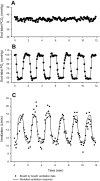Tibetans living at sea level have a hyporesponsive hypoxia-inducible factor system and blunted physiological responses to hypoxia
- PMID: 24030663
- PMCID: PMC3972739
- DOI: 10.1152/japplphysiol.00535.2013
Tibetans living at sea level have a hyporesponsive hypoxia-inducible factor system and blunted physiological responses to hypoxia
Abstract
Tibetan natives have lived on the Tibetan plateau (altitude ∼ 4,000 m) for at least 25,000 years, and as such they are adapted to life and reproduction in a hypoxic environment. Recent studies have identified two genetic loci, EGLN1 and EPAS1, that have undergone natural selection in Tibetans, and further demonstrated an association of EGLN1/EPAS1 genotype with hemoglobin concentration. Both genes encode major components of the hypoxia-inducible factor (HIF) transcriptional pathway, which coordinates an organism's response to hypoxia. Patients living at sea level with genetic disease of the HIF pathway have characteristic phenotypes at both the integrative-physiology and cellular level. We sought to test the hypothesis that natural selection to hypoxia within Tibetans results in related phenotypic differences. We compared Tibetans living at sea level with Han Chinese, who are Tibetans' most closely related major ethnic group. We found that Tibetans had a lower hemoglobin concentration, a higher pulmonary ventilation relative to metabolism, and blunted pulmonary vascular responses to both acute (minutes) and sustained (8 h) hypoxia. At the cellular level, the relative expression and hypoxic induction of HIF-regulated genes were significantly lower in peripheral blood lymphocytes from Tibetans compared with Han Chinese. Within the Tibetans, we found a significant correlation between both EPAS1 and EGLN1 genotype and the induction of erythropoietin by hypoxia. In conclusion, this study provides further evidence that Tibetans respond less vigorously to hypoxic challenge. This is evident at sea level and, at least in part, appears to arise from a hyporesponsive HIF transcriptional system.
Keywords: EGLN1; EPAS1; erythropoietin; high altitude; hypoxic pulmonary vasoconstriction.
Figures








Comment in
-
Less is more: blunted responses to hypoxia revealed in sea-level Tibetans.J Appl Physiol (1985). 2014 Apr 1;116(7):711-2. doi: 10.1152/japplphysiol.01110.2013. Epub 2013 Oct 10. J Appl Physiol (1985). 2014. PMID: 24114703 No abstract available.
References
-
- Allemann Y, Sartori C, Lepori M, Pierre S, Melot C, Naeije R, Scherrer U, Maggiorini M. Echocardiographic and invasive measurements of pulmonary artery pressure correlate closely at high altitude. Am J Physiol Heart Circ Physiol 279: H2013–H2016, 2000 - PubMed
-
- Ang SO, Chen H, Hirota K, Gordeuk VR, Jelinek J, Guan Y, Liu E, Sergueeva AI, Miasnikova GY, Mole D, Maxwell PH, Stockton DW, Semenza GL, Prchal JT. Disruption of oxygen homeostasis underlies congenital Chuvash polycythemia. Nat Genet 32: 614–621, 2002 - PubMed
-
- Balanos GM, Talbot NP, Robbins PA, Dorrington KL. Separating the direct effect of hypoxia from the indirect effect of changes in cardiac output on the maximum pressure difference across the tricuspid valve in healthy humans. Pflugers Arch 450: 372–380, 2005 - PubMed
-
- Beall CM, Brittenham GM, Strohl KP, Blangero J, Williams-Blangero S, Goldstein MC, Decker MJ, Vargas E, Villena M, Soria R, Alarcon AM, Gonzales C. Hemoglobin concentration of high-altitude Tibetans and Bolivian Aymara. Am J Phys Anthropol 106: 385–400, 1998 - PubMed
-
- Beall CM, Cavalleri GL, Deng L, Elston RC, Gao Y, Knight J, Li C, Li JC, Liang Y, McCormack M, Montgomery HE, Pan H, Robbins PA, Shianna KV, Tam SC, Tsering N, Veeramah KR, Wang W, Wangdui P, Weale ME, Xu Y, Xu Z, Yang L, Zaman MJ, Zeng C, Zhang L, Zhang X, Zhaxi P, Zheng YT. Natural selection on EPAS1 (HIF2alpha) associated with low hemoglobin concentration in Tibetan highlanders. Proc Natl Acad Sci USA 107: 11459–11464, 2010 - PMC - PubMed
Publication types
MeSH terms
Substances
Grants and funding
LinkOut - more resources
Full Text Sources
Other Literature Sources

